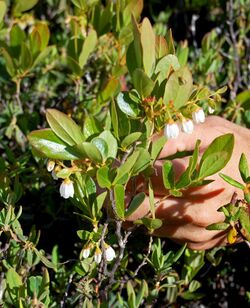Biology:Gaylussacia bigeloviana
| Gaylussacia bigeloviana | |
|---|---|

| |
| Scientific classification | |
| Kingdom: | Plantae |
| Clade: | Tracheophytes |
| Clade: | Angiosperms |
| Clade: | Eudicots |
| Clade: | Asterids |
| Order: | Ericales |
| Family: | Ericaceae |
| Genus: | Gaylussacia |
| Species: | G. bigeloviana
|
| Binomial name | |
| Gaylussacia bigeloviana (Fernald) Sorrie & Weakley 2007
| |
| Synonyms[2] | |
| |
Gaylussacia bigeloviana, also known as the northern dwarf huckleberry or in French as the gaylussaquier de Bigelow, is a plant species native to the coastal plains of eastern Canada and the eastern United States. It grows from Newfoundland to South Carolina in swamps and marshes, including acidic bogs alongside Sphagnum peatmosses.[3][4][5]
Description
Gaylussacia bigeloviana is a shrub up to 1 m (40 inches) tall, sometimes forming small colonies. It has thick, leathery leaves, shiny on the top side, pale green on the underside. Flowers are in groups of 3–7, white, pink, or red. Fruits are black, juicy but bland-tasting.
Conservation
According to NatureServe, the species' conservation status is currently G4G5 (rounded G4) however it has not been reviewed since 1994.[1] More recently updated State/Provincial Statuses demonstrate wide variances with Nova Scotia (S5); New Brunswick, and Massachusetts (S4) reporting secure status while Newfoundland (S3S4); Prince Edward Island, Quebec, Connecticut, New Hampshire, North Carolina, Rhode Island (S2); New York (S1S2); South Carolina (S1) and Delaware (SH) all reporting at-risk status.
References
- ↑ 1.0 1.1 NatureServe. "Gaylussacia bigeloviana Northern Dwarf Huckleberry: NatureServe Explorer 2.0". https://explorer.natureserve.org/Taxon/ELEMENT_GLOBAL.2.143470/Gaylussacia_bigeloviana.
- ↑ "Gaylussacia bigeloviana (Fernald) Sorrie & Weakley". World Checklist of Selected Plant Families (WCSP). Royal Botanic Gardens (Kew). http://www.theplantlist.org/tpl1.1/record/kew-2607189.
- ↑ "Gaylussacia bigeloviana", State-level distribution map from the North American Plant Atlas (NAPA) (Biota of North America Program (BONAP)), 2014, http://bonap.net/MapGallery/State/Gaylussacia%20bigeloviana.png
- ↑ Sorrie, Bruce A.; Weakley, Alan S.; Tucker, Gordon C. (2009), "Gaylussacia bigeloviana", in Flora of North America Editorial Committee, Flora of North America North of Mexico (FNA), 8, New York and Oxford, http://www.efloras.org/florataxon.aspx?flora_id=1&taxon_id=250065725
- ↑ Sorrie, Bruce A. Weakley, Alan S. 2007. Journal of the Botanical Research Institute of Texas 1(1): 333-344
Wikidata ☰ Q15385484 entry
 |


